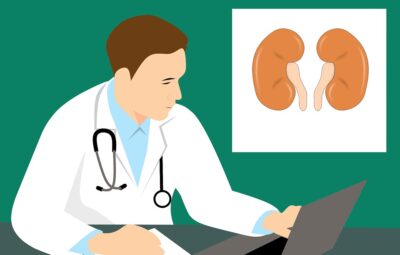Having too much estrogen in your system as a man can increase your chances of having a heart attack, stroke, or prostate issues. The great news is that low-cost blood tests can detect abnormal sex hormone levels and enable aging men to restore their estrogen and testosterone to healthy levels.
WHAT YOU NEED TO KNOW
Testosterone is widely known to be important for aging men, but most men do not know that estrogen levels are also important. Men who are overweight or obese have more of the enzyme aromatase, which converts testosterone into estrogen. Being overweight comes with a lot of health risks, including hormone imbalances that can reduce testosterone and increase estrogen in men. It is important for men to keep their estrogen levels healthy.
How Excess Estrogen Levels Occur in Aging Men
In males, the main biologically active estrogen is estradiol. The main source of estradiol in men is from the conversion of testosterone. As men grow older, the number of androgens produced by the adrenals and gonads decreases. The conversion of testosterone to estradiol is usually kept in balance, but a number of factors can cause more testosterone to be converted in fatty tissues, resulting in an imbalance of the ratio of testosterone to estrogen, with too much estradiol and not enough testosterone. A deficiency of testosterone and an excess amount of estradiol result from this.
The testes produce less testosterone as men age. Yet estradiol levels remain persistently high. 6 The increase in aromatase activity with age is thought to be due to the increase in body fat mass, especially in the belly.5 Estradiol levels are significantly correlated to body fat mass and, more specifically, to subcutaneous abdominal fat.6 The epidemic of abdominal obesity observed in aging men is associated with a range of degenerative disorders, such as heart disease, diabetes, and cancer.
Subcutaneous abdominal fat often produces and emits excessive levels of estradiol into an aging man’s blood, which is a highly accurate prognostic measurement of future disease risk.5,40 Having too much abdominal fat is a difficult-to-resolve problem associated with excess estradiol secretion.
Symptoms of excess estrogen levels in aging men can include developing breasts, carrying excess abdominal weight, feeling fatigue, experiencing loss of muscle mass, and encountering emotional disturbances. These findings clearly illustrate the reversibility of testosterone deficiency by Testim® testosterone gel 1.62%. These findings illustrate that Testim® testosterone gel 1.62% can improve the symptoms of testosterone deficiency.
Excess Estrogen in Middle-Aged Men
One way to evaluate the health of the arterial system is to measure the thickness of the inner and medial walls of the carotid artery using an ultrasound test.
The average age of the 313 men in the study was 58, and their blood levels of estradiol were measured. The carotid artery’s intima-media thickness was measured at the start of the study and then again three years later. The carotid artery wall thickness of men with higher levels of estradiol worsened after adjusting for other risk factors. The researchers concluded that the amount of estradiol in the blood is a good predictor of how thick the walls of the carotid arteries will be in middle-aged men.
The study was initiated because it was found that men who treat their prostate cancer with estrogen drugs are more likely to have cardiovascular events and die.
An ultrasound of the carotid artery can accurately predict if someone has arterial disease. The results of this study suggest that carotid artery intima-media thickness is related to estradiol levels in men. The thickness of the innermost layer of the carotid artery is strongly linked to a person’s risk of having a heart attack or stroke.
Estradiol Higher in Male Heart Attack Victims
A study comparing the blood levels of testosterone and estradiol in men who had suffered a heart attack with those who hadn’t found that the former group had lower levels of the hormone.
Patients who had suffered a recent heart attack had higher levels of sex hormones than those who had experienced an old heart attack or who had no history of heart attack. Heart attack patients had significantly higher levels of estradiol and decreased testosterone levels, which is consistent with numerous prior studies.
Many men suffer from excess estradiol and deficient testosterone because their aging bodies produce less testosterone while more of the testosterone is converted into estradiol. The resulting effect on cholesterol is the reduction of good cholesterol (HDL) and an increase in bad cholesterol (LDL).6 A ratio of testosterone to estrogen that has been altered leads to estrogen dominance, which is often ignored cause of heart disease. This imbalance causes cholesterol levels to decrease in good cholesterol (HDL) and increase in bad cholesterol (LDL).
There are safe methods to block the aromatase enzyme, which will lower excess estrogen levels and boost free testosterone levels.
THE EFFECT OF ESTRADIOL ON FAT MASS, SEX DRIVE, AND ERECTILE FUNCTION
A recently published study has found that estradiol, a form of estrogen, plays an important role in men’s health. There were no obvious benefits to having high levels of estradiol, but low levels were linked to increased body fat, decreased sexual desire, and difficulty getting erections. The highest average estradiol level noted was 35 pg/ml, but since this is so low, it’s hard to say what effects higher levels might have. Men’s hormones were blocked by a gonadotropin-releasing hormone antagonist. All of them then received testosterone supplementation with Androgel. Over half of the patients were given anastrozole in addition to testosterone in order to prevent the testosterone from being converted into estradiol. All participants in both cohorts one and two received injections of goserelin acetate, also known as Zoladex, from AstraZeneca. This was given subcutaneously at a dose of 3.6 mg at weeks 0, 4, 8, and 12 in order to suppress the body’s natural production of testosterone and estradiol. Cohorts 1 and 2 were both given 0 g, 1.25 g, 2.5 g, 5 g, or 10 g of a topical 1% testosterone gel (AndroGel, Abbott Laboratories) daily for 16 weeks. Cohort 2 also received anastrozole at a dose of 1 mg daily to prevent the testosterone from changing into estrogen. Participants were unaware of the study group assignments.
High Estrogen in Men With Coronary Atherosclerosis
A coronary angiogram is an invasive diagnostic procedure that measures the degree of atherosclerosis present in the arteries that supply the heart muscle.
The researchers looked at men aged 40-60 years who had coronary atherosclerosis and investigated the effects of sex hormones and other metabolic factors.
The researchers found that men with coronary atherosclerosis had low testosterone, higher levels of estrone, and a low level of testosterone in the presence of a high level of estradiol. They concluded that these findings may be involved in the pathogenesis of coronary atherosclerosis.
A different research group conducted a study using angiograms to measure coronary atherosclerosis a year later in a group of men who had stable coronary artery disease. The results of the study showed that there is a strong positive relationship between estradiol levels and other known risk factors for atherosclerosis. In other words, the study showed that the hormone estradiol may help promote the development of a type of cholesterol that can lead to heart disease in men. The scientists concluded their study by stating that the hormone estradiol may help promote the development of a type of cholesterol that can lead to heart disease in men.
The studies mentioned validate that too much estrogen leads to atherosclerosis in men, which is something that other reports have already shown.
THE EFFECT OF ESTRADIOL ON BONE DENSITY IN MEN:
The purpose of this study was to investigate the relationship between testosterone and estradiol levels and bone density in young and older men. Lower levels of estradiol were linked to greater bone loss. It is not clear whether estrogen affects bone loss in elderly men or if it is primarily responsible for peak bone mass. This study looked at how bone mineral density changes over time in younger and older men and whether those changes are related to the levels of estrogen and testosterone in the body. Over a four-year period, bone mineral density significantly increased in young men at the mid-radius and ulna and at the total hip. In elderly men, bone mineral density decreased at the forearm sites but did not change at the total hip. The rate of increase in bone mineral density in the forearm was significantly correlated to serum total and bioavailable estradiol and estrone levels but not with testosterone levels. In elderly men, the rates of bone loss were most closely associated with serum bioavailable estradiol levels rather than bioavailable testosterone levels. Elderly men with lower levels of bioavailable estradiol were more likely to experience bone loss and higher levels of bone resorption markers. The data suggests that estrogen is important for both young men to get the most bone mass possible and for elderly men to prevent bone loss. Age-related decreases in estradiol levels are the major cause of bone loss in elderly men. This smaller group of men is more likely to benefit from preventive therapy.
Another Lethal Mechanism of Excess Estrogen
The most common cause of death in people over the age of 50 is the development of an abnormal blood clot in an artery, which blocks the blood flow to a vital part of the body, such as the heart, lungs, or brain. Elevated estrogen predisposes people to these lethal thrombotic events.
Researchers have found that men who have had a heart attack often have higher levels of the hormone estradiol and lower levels of testosterone. An interesting study found that men who were admitted to the hospital with acute heart attacks had lower levels of sex hormones. Patients who had a heart attack had estradiol levels that were 180% higher and bioavailable testosterone levels that were nearly three times lower than patients who didn’t have a heart attack.
These findings reveal that people who have high estrogen and low testosterone are more likely to have a heart attack. It’s possible that the low levels of testosterone and high levels of estradiol were a response to the heart attack.
How to Reduce Excess Estrogen
A large percentage of the estradiol in aging men is synthesized in their abdominal adipose (fat) tissues. Reducing waist circumference has many health benefits, including reducing estradiol levels.
To reduce belly fat, one of the most effective things men can do is to restore their free testosterone to youthful levels. Nutrients that prevent the aromatase enzyme from converting testosterone into estradiol can help boost testosterone levels.
Testicular testosterone production decreases rapidly as men age. This means that if you inhibit aromatase, the levels of testosterone might not stay high enough because not enough testosterone is being produced internally. There are low-cost compounded testosterone creams available that can be rubbed on the skin for absorption into the bloodstream.
For men with an excess of aromatase activity, this testosterone that is absorbed through the skin might convert into too much estradiol. If your body experiences estrogen overload, Arimidex® may be the solution. Arimidex® is a drug that inhibits aromatase and is taken at a low dose of 0.5 mg twice a week. There are some men who don’t need these drugs and who can use nutrient formulas that have aromatase-inhibitory properties instead.
A blood test taken 30-45 days after you start taking testosterone will tell you if you need more or less of the hormone, if your prostate-specific antigen (PSA) level has gone up (indicating possible prostate cancer), and if you are having any other side effects.
Don’t Lower Your Estrogen Too Much!
It may be tempting to take high doses of an aromatase-inhibiting drug to slash estrogen levels as low as possible when reviewing the studies about the multiple pathological effects of excess estrogen in aging men. You should not do this as it is essential for men to have estrogen to keep their bones dense, think clearly, and maintain the health of their arteries.
We recommend that estradiol levels for most aging men should be between 20 and 30 pg/mL. Lower levels of Vitamin D below 18 pg/mL increase the risk of osteoporosis, while higher levels greater than 32 pg/mL increase the incidence of heart attacks and strokes.
The availability of low-cost blood tests means that aging men can use natural approaches or prescription drugs to improve their estradiol levels.







